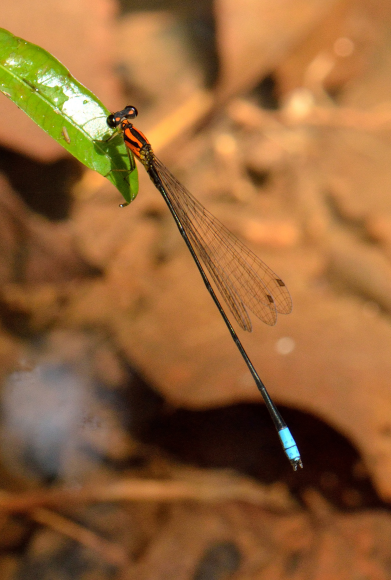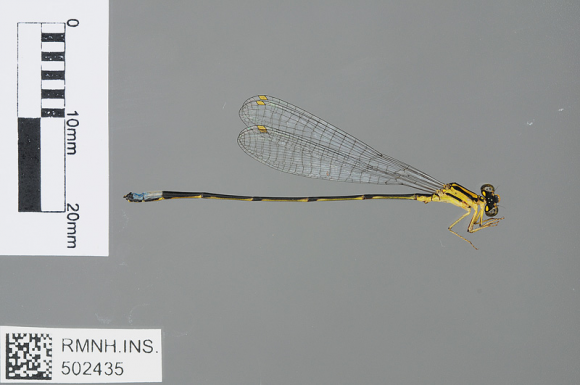Pseudagrion (A) dactylidium Dijkstra & Mézière, 2015
Gabon Slim Sprite
Type locality: Moyabi, Gabon
Diagnosis
Male is similar to the sympatric P. hemicolon and P. thenartum by (a) the small size, Hw 20.5-22.0 mm (n = 5); (b) the slender build; (c) the bright orange, though yellow when preserved, postocular spots and thorax, with broad antehumeral stripes; (d) the largely pale legs; and (e) the reddish Pt, although also yellowish when preserved. Separated reliably from P. thenartum only by (1) the sleeker cerci in dorsal view, the distal section being distinctly narrower than the basal section with the lower flange largely reduced. This shape is intermediate between the also sympatric (but blue-bodied) P. simplicilaminatum and P. thenartum, in which the tip is at least as wide as the base and the flange is even wider and strongly rounded. Also differs from P. thenartum by (2) the blacker thorax, although there is overlap: the orange of the antehumeral stripe typically touches the humeral suture over a shorter distance and does not cross to the mesepimeron at the posterior end of this suture, the wide part of the black humeral stripe thus appearing less pronounced, and there is always a black stripe along nearly the full length of the metapleural suture, which often reaches the metastigma and even metakatepisternum; the latter is typically ill-defined or even reduced to a black dot at the posterior end of this suture in P. thenartum. [Adapted from Dijkstra, Kipping & Mézière 2015]
Habitat description
Mostly standing and often temporary waters, but possibly also seeps, springs and headwater streams, shaded by forest. Usually with coarse detritus, a soft (like muddy) bottom and often emergent vegetation, if at streams probably especially calmer sections (like pools). From 400 to 700 m above sea level.
Distribution

© Nicolas Meziere
Map citation: Clausnitzer, V., K.-D.B. Dijkstra, R. Koch, J.-P. Boudot, W.R.T. Darwall, J. Kipping, B. Samraoui, M.J. Samways, J.P. Simaika & F. Suhling, 2012. Focus on African Freshwaters: hotspots of dragonfly diversity and conservation concern. Frontiers in Ecology and the Environment 10: 129-134.
Barcode specimen(s):

Male; Gabon, Haut-Ogooué, MOUYEUGUE-Moanda-Bakoumba Road © Dijkstra, K.-D.B.

Male; Gabon, Haut-Ogooué, MOUYEUGUE-Moanda-Bakoumba Road © Dijkstra, K.-D.B.

Male; Gabon, Haut-Ogooué, DATA MISSING
Reference
- Dijkstra, K.-D.B., Mézière, N., and Kipping, J. (2015). Sixty new dragonfly and damselfly species from Africa (Odonata). Odonatologica, 44, 447-678.
Citation: Dijkstra, K.-D.B (editor). African Dragonflies and Damselflies Online. http://addo.adu.org.za/ [2024-07-27].

